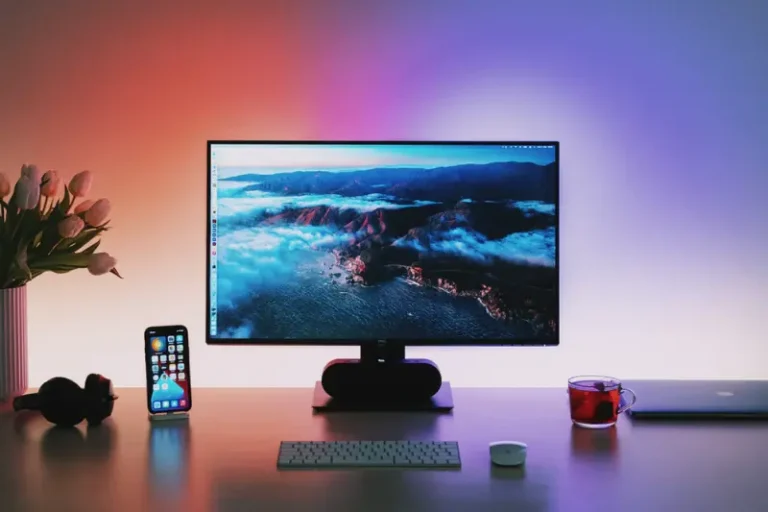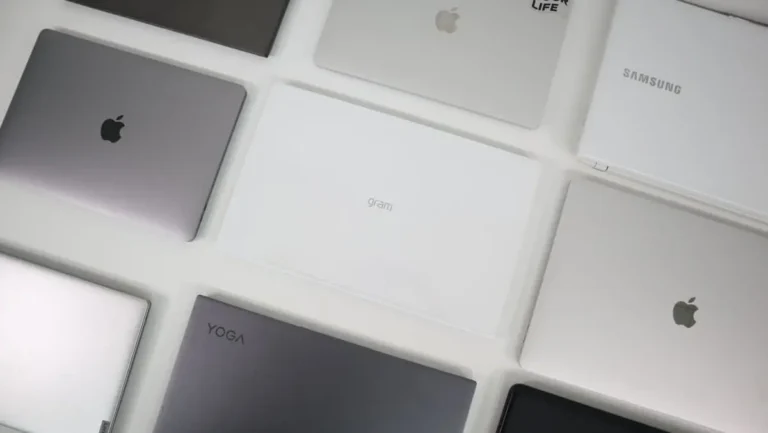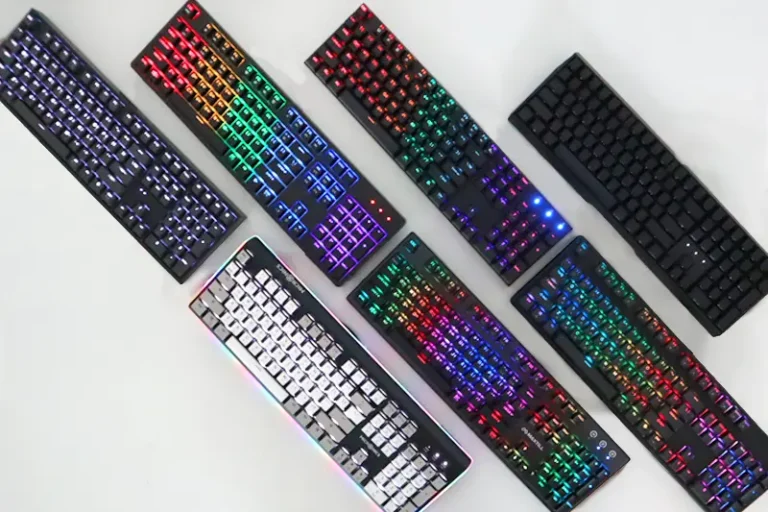The Best Mouse Buying Guide
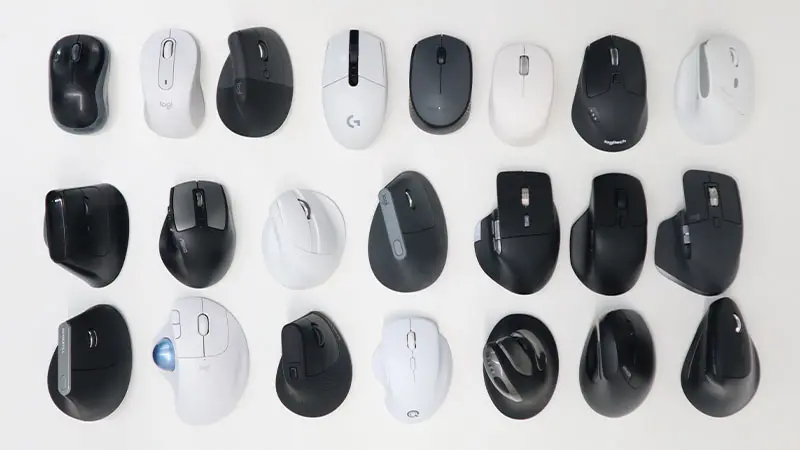
Your Guide to Choosing a Mouse That Fits Perfectly
Along with your keyboard, your mouse is a device you’ll be holding all day long. Since it’s a product that your hand will be in direct contact with for extended periods, it’s important to choose a mouse that perfectly matches your needs and preferences.
Let’s explore how to select the perfect mouse from the many different types and countless options available, finding the one that fits your hand just right.
Chapter 1.
Mouse Types
Type / Symmetry / Wired-Wireless / Honeycomb / Grip Style
Mice come in various shapes and designs. Let’s look at the most common types and their pros and cons, plus understand grip styles and hand measurement methods crucial for choosing the right mouse shape.
1. Mouse Types
Classification by Mouse Shape
Standard/Semi-Vertical/Vertical/Trackball
Standard Type – Most Common
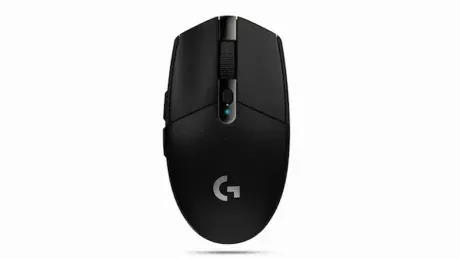
This is currently the most commonly used mouse type.
If you’re using a standard mouse without wrist pain or other issues, sticking with this type is recommended. While vertical mice and trackballs can help reduce wrist strain, their unique shapes require significant adjustment time.
Vertical Mouse – Reduces Wrist Strain
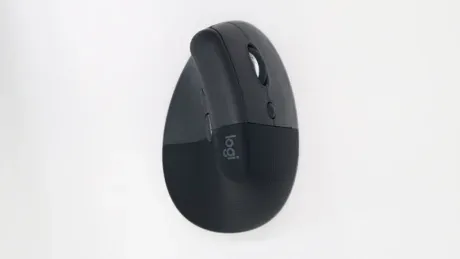
Standard flat mice force your palm to stay horizontal, twisting your wrist. This twisting of wrist joints and muscles can lead to numbness and fatigue in your wrist and fingers after extended use. In severe cases, this can develop into carpal tunnel syndrome.
Vertical mice are designed to prevent this issue by allowing natural wrist positioning. Most have an elongated vertical shape to reduce wrist strain and include auxiliary buttons.
However, users unfamiliar with vertical mice might experience increased pain initially, and some report shoulder tension leading to arm fatigue. The increased height can also cause accidental bumping when moving your hand to the keyboard – a minor but noticeable issue.
Semi-Vertical = Middle Ground
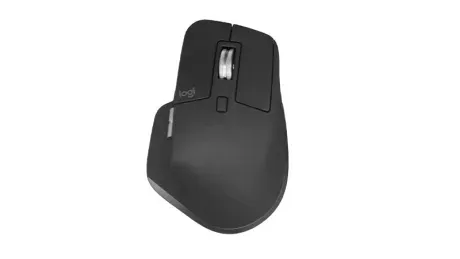
For those who find vertical mice too extreme but need wrist pain relief, semi-vertical mice offer a gentler angle. They reduce wrist strain while remaining familiar enough for standard mouse users to adapt easily.
Trackball – Thumb-Controlled Pointer
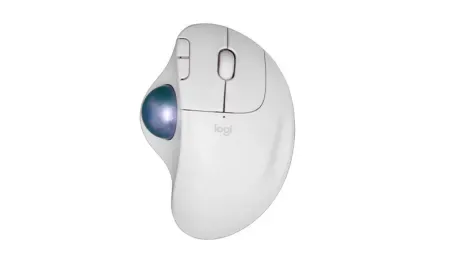
This design moves the ball to the thumb area, controlling the pointer by rolling the ball rather than moving the entire mouse.
While it’s suitable for those with weak wrists due to reduced strain, the long adjustment period requires careful consideration before purchase. Unless severe wrist pain forces adaptation, this type is rarely chosen.
2. Mouse Symmetry
Symmetrical : Identical Left/Right Sides
Asymmetrical : Different Shaped Sides
Symmetrical- Same Shape Both Sides
Usable by Both Left and Right-Handed Users
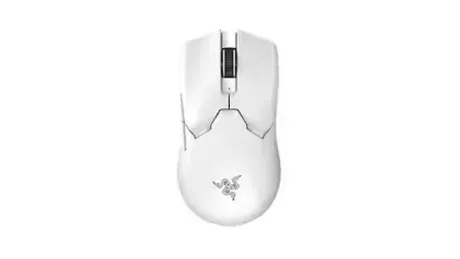
Symmetrical mice have identical shapes on both sides and can be used by either hand. However, since human hands aren’t symmetrical, this design might cause strain on fingers or wrists.
Asymmetrical- Different Left/Right Shapes
Difficult for Left-Handed Use
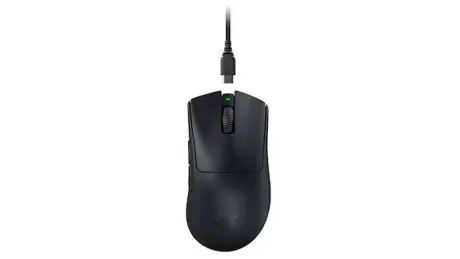
Asymmetrical mice typically have thumb indentations or auxiliary buttons on one side. They’re more ergonomic than symmetrical mice, and all vertical mice are asymmetrical.
Mouse Shape Suitability Varies by Grip Style
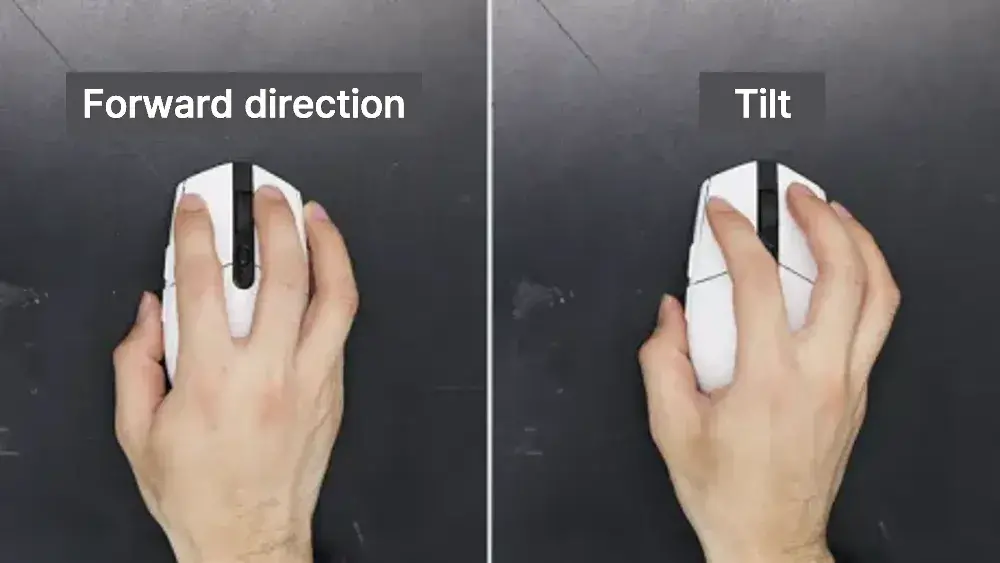
While asymmetrical mice are considered more ergonomic, personal preference and grip style matter more.
If you hold your mouse straight on, either symmetrical or asymmetrical works fine.
However, if you naturally tilt your hand (wrist tilted with right side touching the surface = tilt grip), an asymmetrical mouse might be more comfortable. These mice are specifically designed for this tilted grip style.
Check how your wrist naturally rests – if both sides touch evenly, consider symmetrical; if the right side touches more, consider asymmetrical.
Note: This is just a recommendation. If you’re comfortable using a symmetrical mouse with a tilted grip, that’s perfectly fine!
3. Honeycomb/Solid
Honeycomb: Shell with Holes
Solid: Traditional No-Hole Design
Honeycomb Design : Lighter & Less Palm Sweating
But Collects Dust and Feels Different
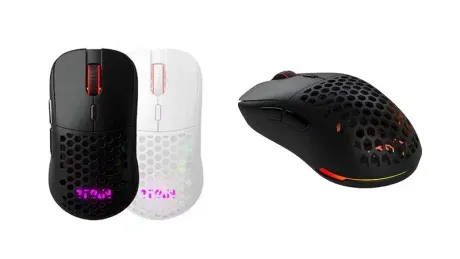
The mouse shell is the outer casing that determines grip feel.
Honeycomb mice have holes drilled in the shell for weight reduction.
While lighter and better for palm ventilation, they:
– Collect dust and dirt between holes, requiring frequent cleaning
– Can feel unusual due to the holes against fingers and palm
– Are vulnerable to liquid damage
Solid Design – The Original Mouse Shell
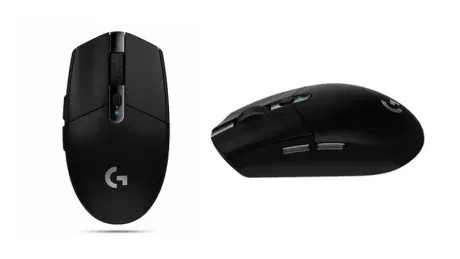
While honeycomb designs were introduced for weight reduction, traditional mice had solid shells.
Solid mice offer:
– Sturdy feel from the added weight
– Easier maintenance
– Consistent grip feel without holes (Basically, the opposite of honeycomb advantages!)
4. Mouse Connection Types
Wired : Affordable with Fast Response
Wireless : Convenient but Costlier
Wireless Response Times Improving
Wired: Affordable and Fast Response
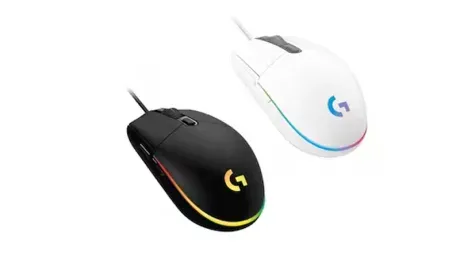
Wired mice connect via USB cable, offering lower prices and faster response times than wireless. With no signal transmission delay, some high-end gaming mice still opt for wired connections for optimal performance.
Regular Rubber/Fabric vs.
Low-Resistance Paracord Cables
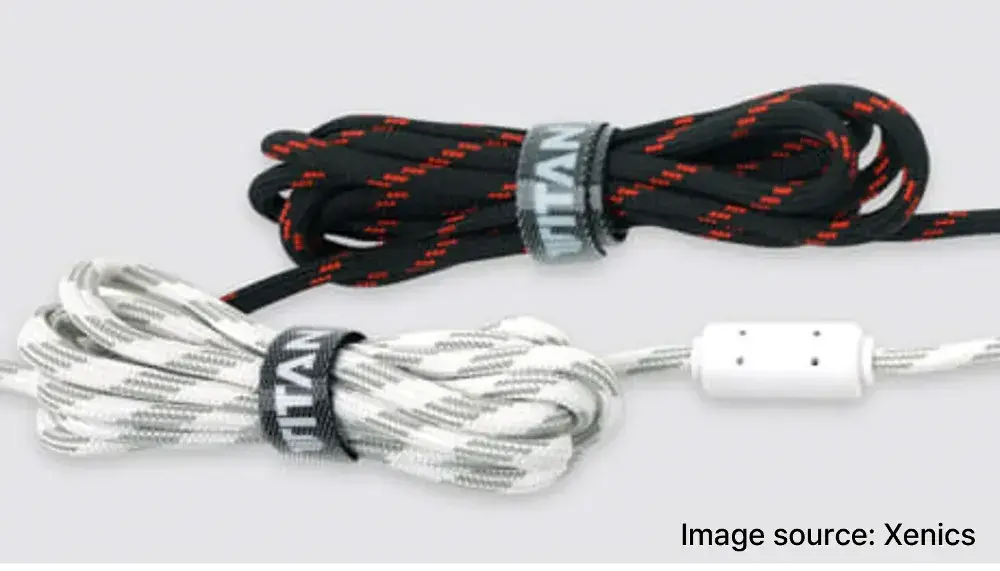
Professional gaming mouse manufacturers often use paracord cables instead of standard rubber or braided cables to minimize resistance and improve flexibility.
Users report less tangling, fewer cable marks, and better weight distribution due to reduced cable resistance. *Paracord (parachute cord): Nylon cord originally used in parachutes, known for softness and minimal tangling
Wireless Connections: Dongle vs. Bluetooth
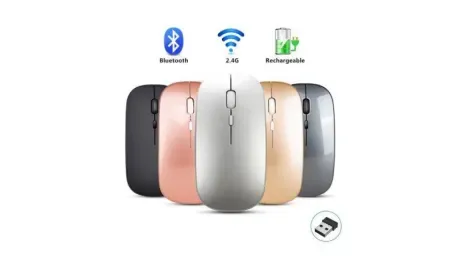
Wireless mice connect either through a small USB receiver (dedicated dongle) or Bluetooth.
Dongles provide 1:1 connections, limiting use to one device at a time. Bluetooth, however, often supports multi-pairing (connecting to several Bluetooth devices), allowing easy switching between devices. It also saves USB ports since no receiver is needed.
For Multi-Device Use
Choose Models with Device Switch Buttons
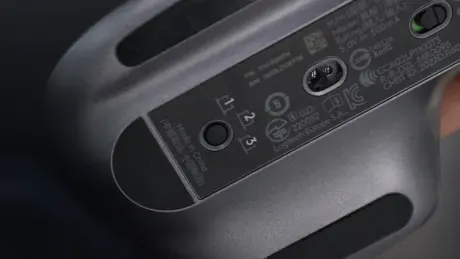
When using a wireless mouse with multiple devices, easily accessible device switching is important.
Button switches are more convenient than sliding switches, and placement matters – look for thumb-accessible locations or below the scroll wheel.
Logitech’s Unifying/Logi Bolt Receivers
One Dongle for Multiple Devices

Some Logitech mice support either Unifying or Logi Bolt receivers, which can connect multiple wireless mice and keyboards to one dongle.
Due to security vulnerabilities, Unifying was replaced by Logi Bolt in September 2021 as Logitech’s new wireless standard.
Unifying receivers have a red star icon, while Logi Bolt uses a fluorescent lightning bolt icon.
Note: Unifying and Logi Bolt devices are not compatible.
Hybrid Wired/Wireless Options Available
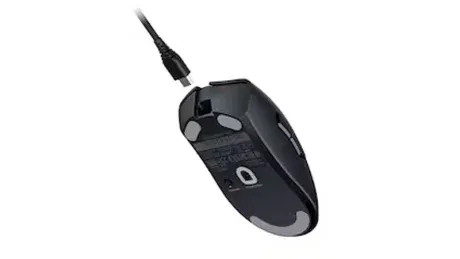
Some mice include ports allowing both wired and wireless use. This feature is common in gaming mice where response time is crucial.
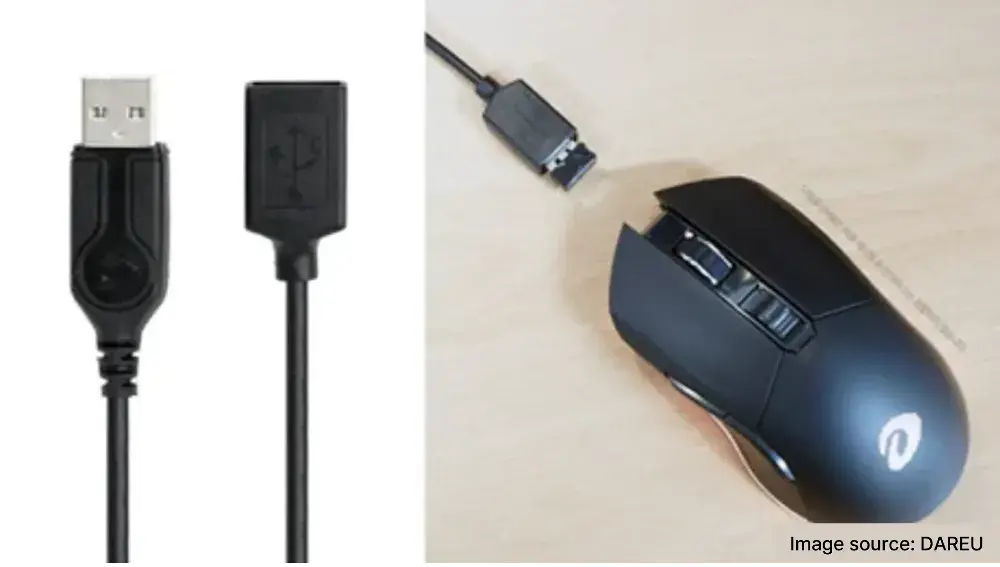
Some models even include extension cables to position wireless dongles closer to the mouse for reduced latency.
5. Grip Styles
Palm/Claw/Fingertip Grip
Different Mouse Shapes Suit Different Grips
Many Ways to Hold a Mouse
Palm/Claw/Fingertip Most Common
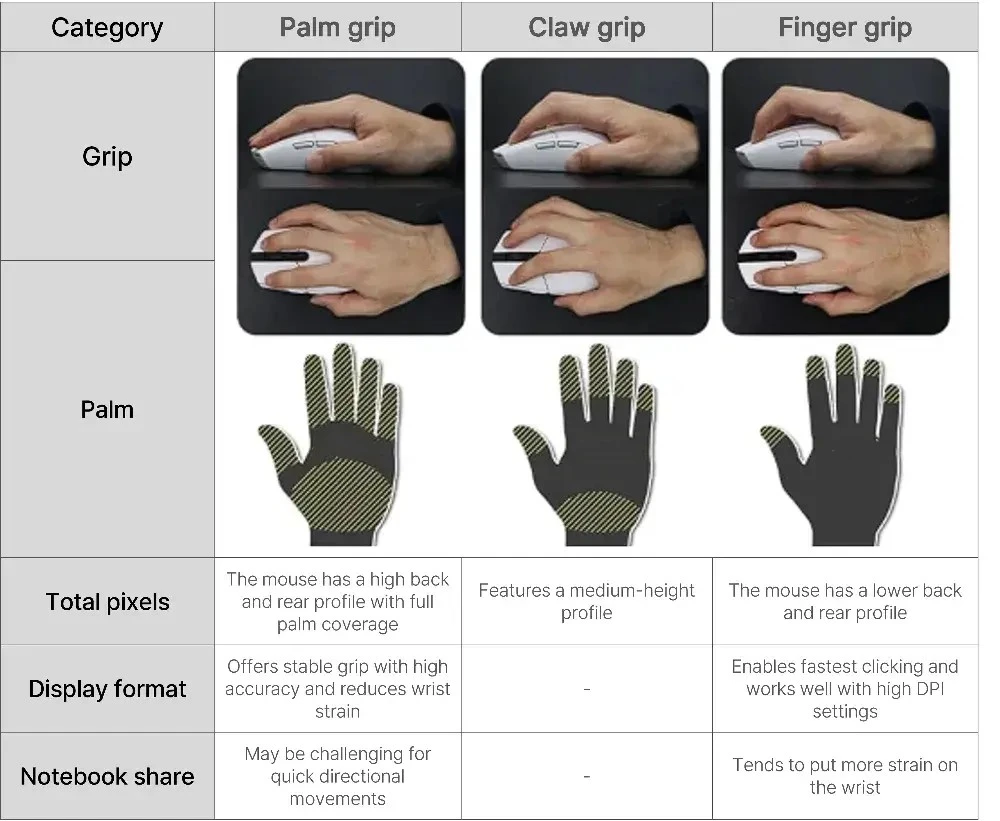
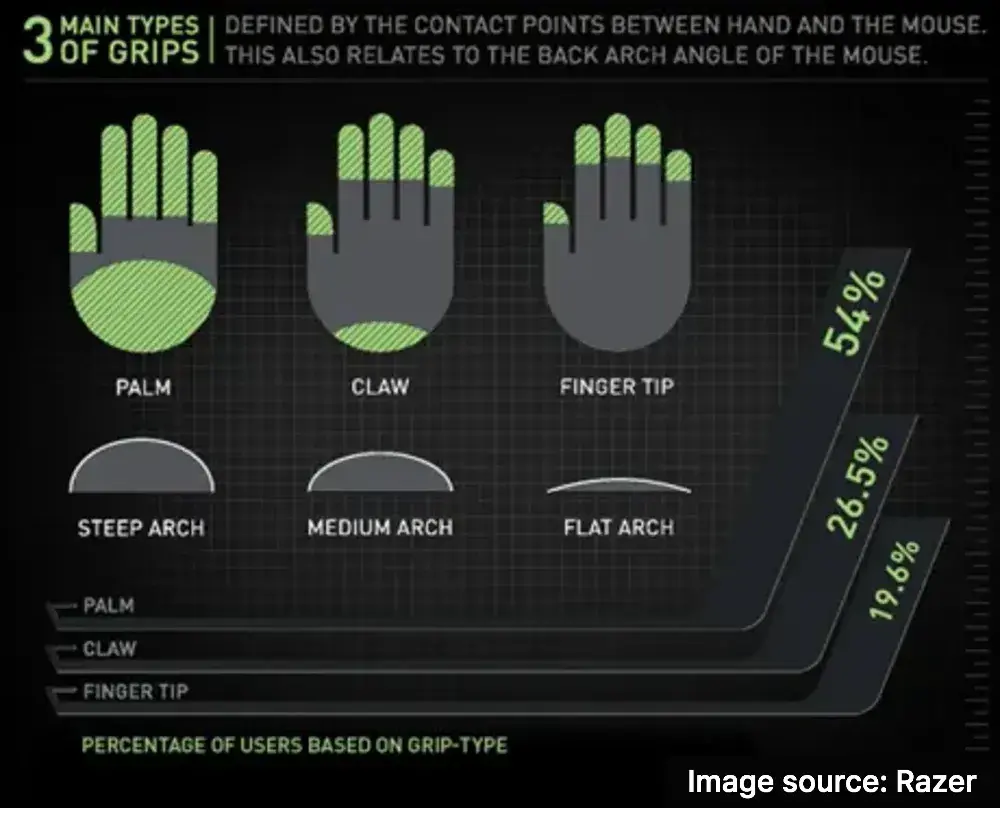
As mentioned in the symmetry section, there are many ways to hold a mouse. However, three main styles (Palm/Claw/Fingertip) are recognized, and manufacturers generally design around these grip types.
Palm Grip: Full Hand Contact
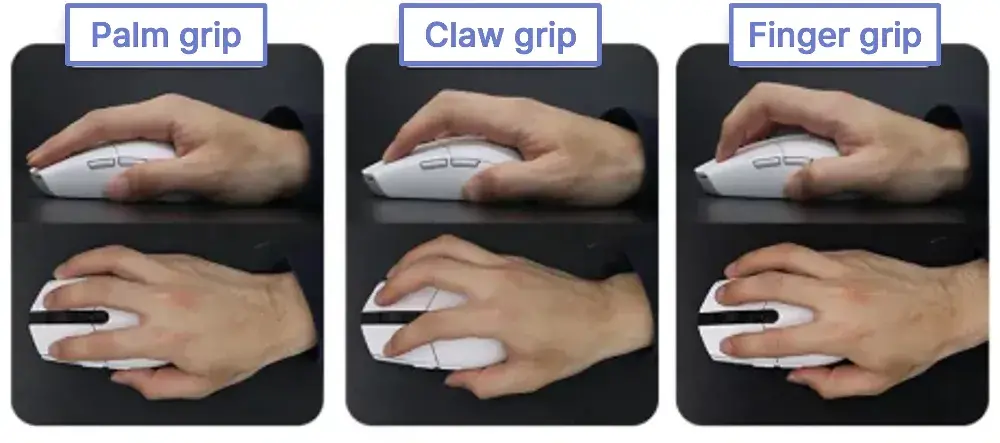
Palm grip uses your entire palm to hold the mouse. Both palm and fingers maintain contact with the mouse surface. This grip typically involves arm movement more than wrist movement and is the most common style. For palm grip users, choose mice with higher backs and bases for full palm support.
Claw Grip: Fingertip and Palm Edge Contact.
Named after claw-like hand position, claw grip uses fingertips and rear palm to hold the mouse.
This grip allows faster clicking than palm grip. Choose mice with some rear height but lower profiles since palm shouldn’t fully contact the surface.
Fingertip Grip: Fingertip Control Only
Fingertip grip uses only fingertips to control the mouse, with palm hovering above. The palm stays grounded while the wrist moves the mouse.
This grip is favored for games requiring quick reactions, offering high cursor precision despite potential wrist strain. Flat, lightweight mice work best since palm doesn’t contact the mouse.
6. Hand Size Measurement
Total Palm Length and Width
Measure Before Buying

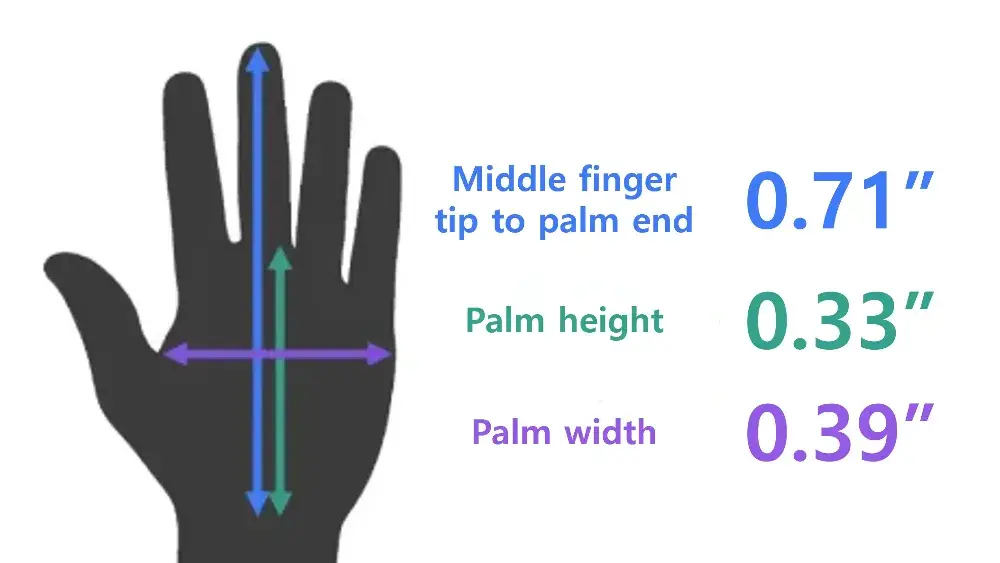
After determining your grip style, measure your hand size.
Measure:
1) Length from bottom of palm to middle fingertip
2) Length from bottom of palm to base of middle finger
3) Palm width
Compare these measurements with mouse dimensions listed in product specifications.
Average adult hand sizes :
Men: 18.3 x 10.5cm
Women: 17 x 9.6cm
(Palm-only length data unavailable) Since specifications alone can be hard to visualize, measure your current mouse and use it as a reference point when comparing sizes of new mice.
Chapter 2.
Mouse Sensors & Switches
Complete Guide to Complex Mouse Terminology
While mouse shape and size are visible to the eye, technical specifications include puzzling terms like DPI, sensor types, and response rates. Let’s clarify these product page specifications and understand which specs matter most for different uses.
1. Sensors
Different Sensor Types Affect
DPI/IPS/FPS/Acceleration
How Optical Mice Work Tracking
Movement by Recording Surface Images
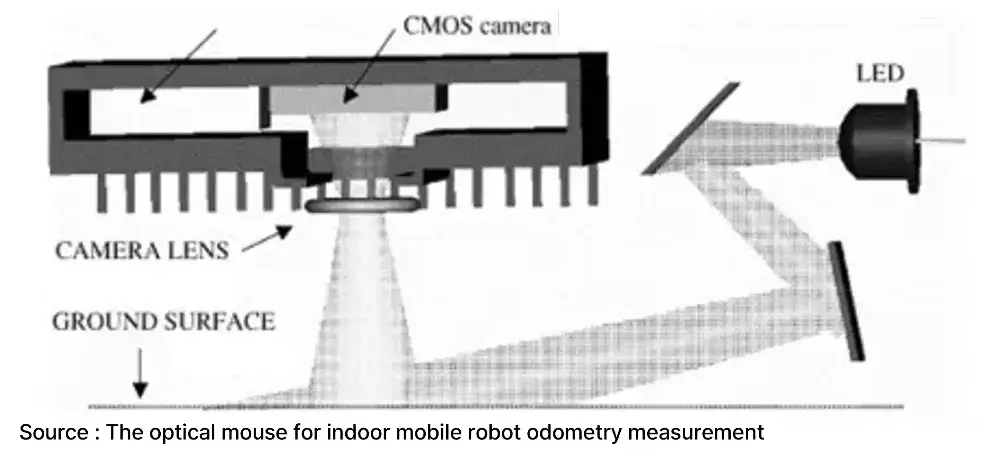
Let’s first understand the principle behind optical mice, which is how almost all modern mice operate.
The mouse lens continuously captures images of the surface below, like recording a video. These images are processed to enhance contrast, making white areas pure white and darker areas pure black.
The mouse then tracks black dot coordinates to measure movement. The mouse’s internal processor calculates this movement to determine cursor position.
Different Manufacturers Use Different Sensors
PIXART and Logitech Sensors Most Popular
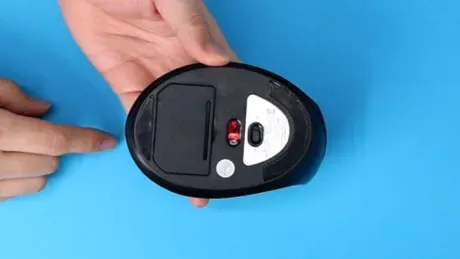
| Sensor | DPI(CPI) | IPS | Acceleration |
|---|---|---|---|
| PAW 3395 | 26000 | 650 | 0.11 lbs |
| Focus+ | 20000 | 650 | 0.11 lbs |
| PAW 3399 | 20000 | 650 | 0.11 lbs |
| PMW 3370 | 19000 | 400 | 0.11 lbs |
| TrueMove Pro | 18000 | 450 | 0.11 lbs |
| Hero 16k | 16000 | 400 | 0.088 lbs |
| PMW 3390 | 16000 | 450 | 0.11 lbs |
| PMW 3389 | 16000 | 400 | 0.11 lbs |
| TrueMove Air | 16000 | 400 | 0.088 lbs |
| PAW 3369 | 16000 | 400 | 0.088 lbs |
| PAW 3338 | 16000 | 400 | 0.088 lbs |
| PAW 3335 | 16000 | 400 | 0.088 lbs |
| TrueMove 3 | 12000 | 250 | 0.11 lbs |
| Hero | 12000 | 400 | 0.088 lbs |
| PMW 3361 / Owl Eye | 12000 | 250 | 0.11 lbs |
The sensor isn’t just what you see on the mouse bottom.
Mouse specifications often list sensor models like PMW-33##. This is the actual sensor name.
PIXART’s PMW series and Logitech’s HERO sensors are most renowned, though some manufacturers use custom sensors or modified PMW variants.
For PMW sensors, higher numbers typically indicate better performance. Sensor types affect DPI, IPS, acceleration, and FPS specifications. Let’s examine what each means.
DPI (Dots Per Inch)
Pixels Moved Per Inch of Mouse Movement
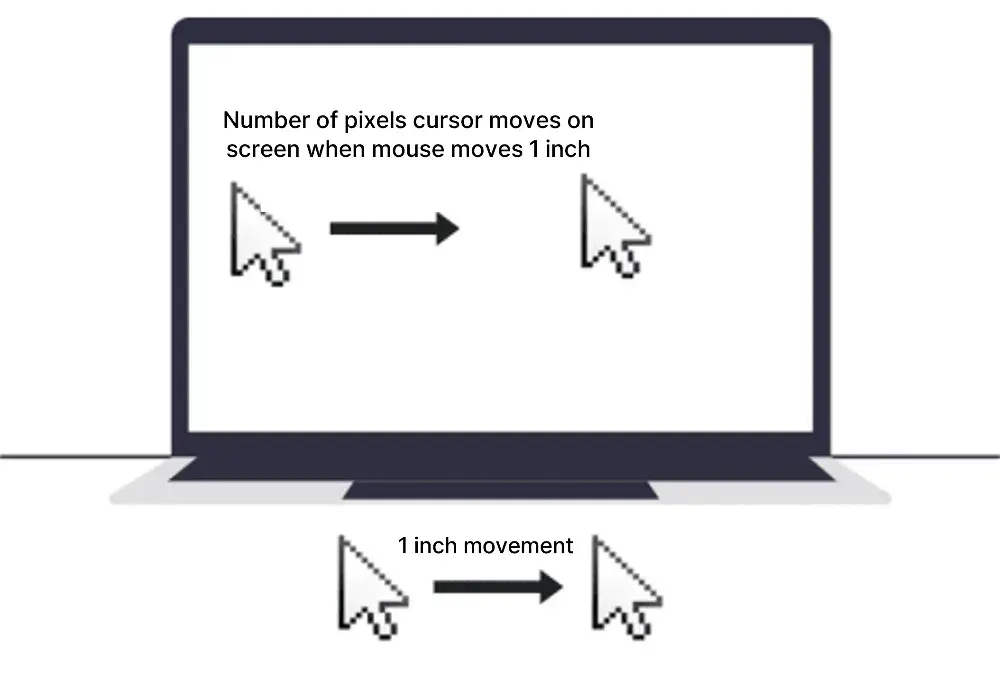
DPI (Dots Per Inch), also called CPI (Counts Per Inch), measures how many pixels the cursor moves when you move the mouse one inch. Higher DPI means smaller physical movements create larger cursor movements. Standard mouse sensors offer 4000 DPI, while newer models reach 10,000-30,000 DPI.
Most users set DPI between 400-1200, as higher settings make the pointer move too fast for practical use.
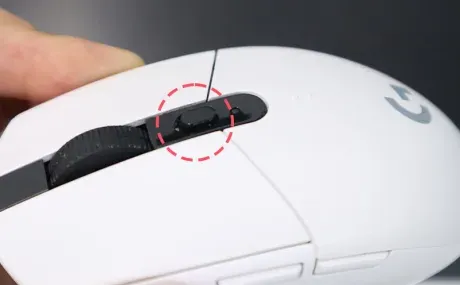
While higher DPI sounds better, it’s often an overspecification that’s imperceptible in real use. Some mice include DPI adjustment buttons near the scroll wheel, or allow software adjustment.
IPS (Inches Per Second)
Maximum Speed Mouse Can Track

IPS (Inches Per Second) measures how fast the mouse can move while still tracking accurately.
While important for rapid mouse movements, like DPI, current sensor specs far exceed human capabilities, making it less relevant for practical use.
For example, a 100 IPS mouse can track movements up to 100 inches per second – about 9 km/h. If you can’t move the mouse faster than that, higher IPS becomes meaningless. Most office mice exceed 100 IPS, while gaming mice typically offer 200+ IPS.
FPS (Frames Per Second)
Sensor Surface Scan Rate
FPS measures how many images the sensor captures per second. Optical mice work by continuously photographing the surface to detect movement changes. FPS indicates this capture rate. Many manufacturers don’t list FPS as it’s rarely noticeable in normal use.
Polling Rate
Mouse-Computer Communication Frequency
Polling rate indicates how often the mouse and computer exchange signals per second. Usually ranges from 125-1000Hz, with premium models reaching 4000Hz.
Most wired mice, even budget models, offer 1000Hz polling rates. Many wireless dongle mice also achieve 1000Hz.
However, Bluetooth connections typically range from 125-250Hz. Gaming mice should have 1000Hz+ polling rates for optimal response times.
Mouse Sensor Specs
Now Exceed Human Perception Limits
Sensor Type Less Critical
After reviewing mouse sensor specifications, it’s worth noting that modern sensors typically exceed what users can perceive. Even budget sensors often surpass human perception limits.
While extremely sensitive users might notice differences, most casual users won’t perceive these spec variations. Therefore, rather than focusing on sensor types, consider shape, grip feel, weight, and additional features when choosing a mouse.
2. Mouse Switches
Mechanical/Optical Most Common
Silent Switches Best for Office Use
Office mice often don’t specify switch information. Gaming mice and premium models, where switch feel and click response matter more, often detail switch specifications. Let’s examine the differences between switch types.
Mechanical Switches – Most Common
But Prone to Double-Click Issues
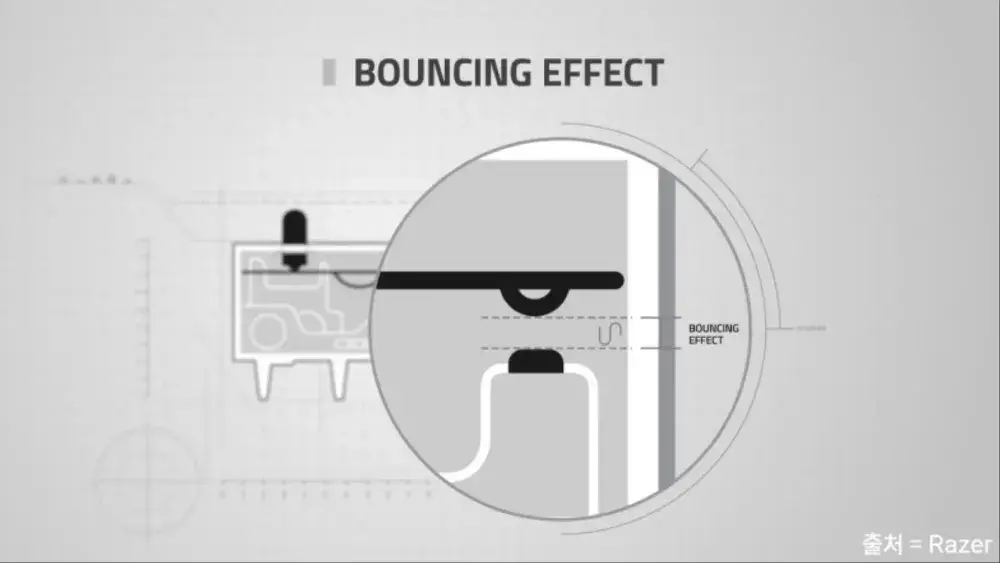
When people talk about mouse switches, they usually mean mechanical switches.
These contain a spring supporting a contact point. When you press the button, the spring bends, connecting the contact point to the switch base to register a click.
As contact points wear down, these switches can develop “double-click” issues, where single clicks register as doubles. Logitech’s notorious double-click problems stem from using mechanical switches.
Switch durability (click lifespan) varies, but typically handles 10 million clicks.
The most renowned manufacturers are OMRON, HUANO, and Kailh. *Note: OMRON switches are sometimes differentiated by manufacturing location as “Omron China” or “Omron Japan” (Many users report Chinese-made switches develop double-click issues sooner)
Optical Switches – No Double-Click Issues
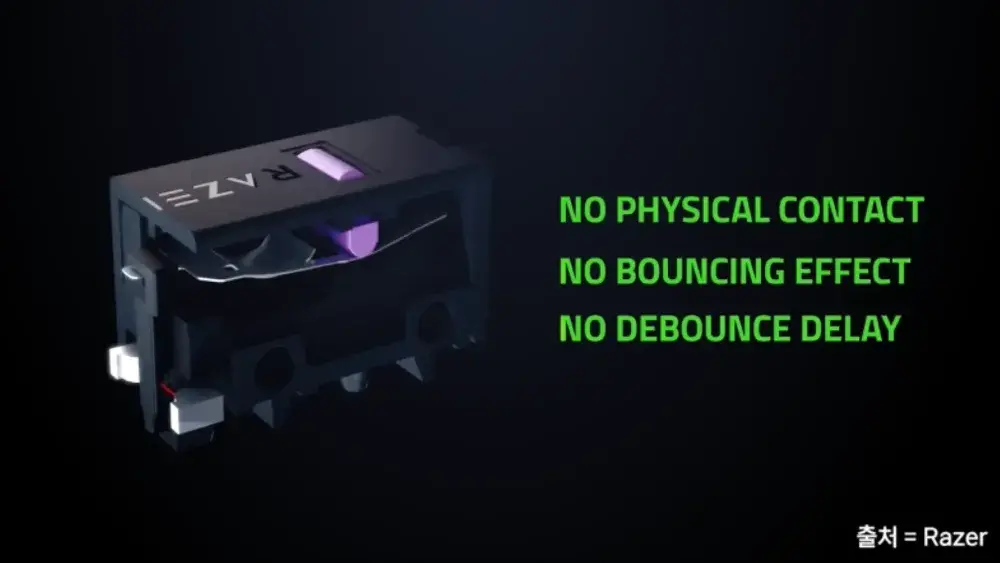
These switches use optical sensors that generate current when receiving light. They detect clicks by measuring current changes when light is blocked.
Without physical contact points, they avoid double-click issues and offer superior durability compared to mechanical switches.
If you’ve had to replace multiple mice due to double-click problems, consider optical switches. Razer and ROCCAT are major manufacturers of optical switch mice.
Silent Switches – No Click Sound
Perfect for Office Use
If mouse click sounds bother you, choose silent switch models.
These are popular in quiet environments like offices, libraries, and study rooms.
While the click feel might be slightly less distinct, they significantly reduce noise. When shopping for silent mice for quiet environments, check that both buttons AND scroll wheel are silent.
Chapter 3.
Mouse Size & Weight
There’s no perfect answer for mouse size and weight. With so many variables beyond grip style and hand size, this guide won’t instantly lead you to your dream mouse. However, following these guidelines should help you find a satisfactory mouse and provide a foundation for future purchases.
1. Size
Recommend Similar Shape to Current Mouse
If Changing Style, Consider Hand Size and Grip
Consider Your Current Mouse Size
As we discussed hand size and grip styles earlier, you should consider three factors: your current comfortable mouse shape, hand size, and grip style when choosing a new mouse.
The safest approach is selecting a mouse similar to your current comfortable one. Mice often take longer to adjust to than expected, and if a mouse truly doesn’t fit your hand, no amount of time will make it comfortable.
Selection Based on Hand Size
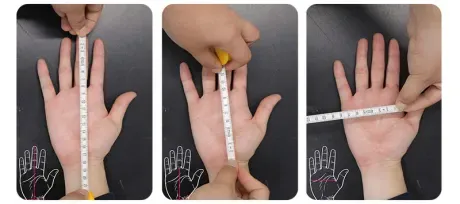
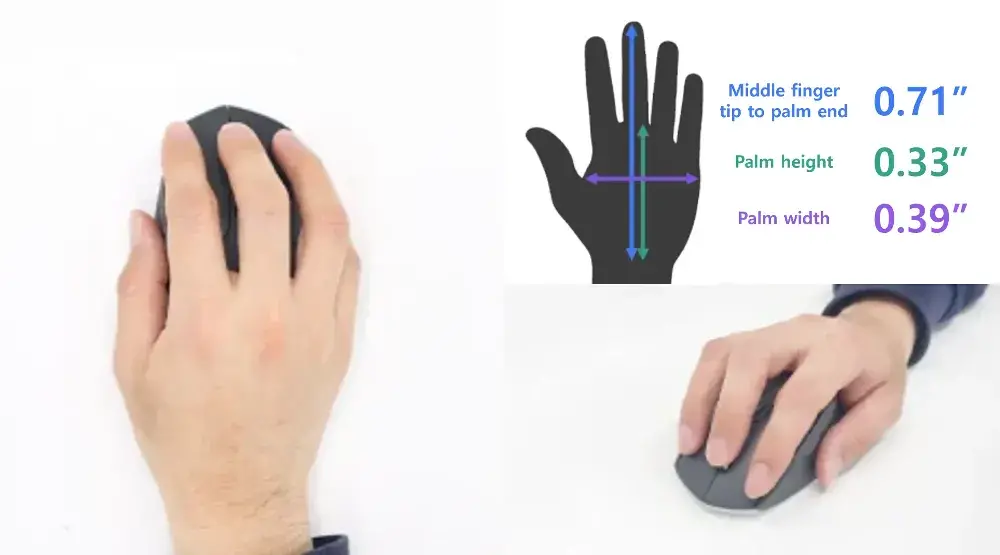
Consider both total palm length and width. While not definitive, here’s a general guideline: mouse length should be about 65% of total palm length for small size, 65-75% for medium size, and over 75% feels large.
Mouse Size Selection by Grip Style
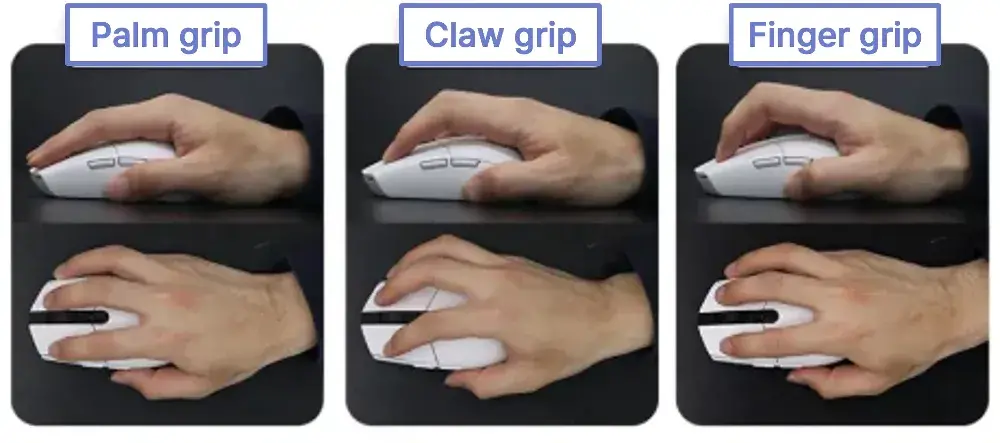
If you want to try a different mouse style, consider both grip style and hand size to minimize risk of a poor choice.
First, identify your grip style based on our earlier discussion. For palm grip, choose regular or slightly larger size for stable hold.
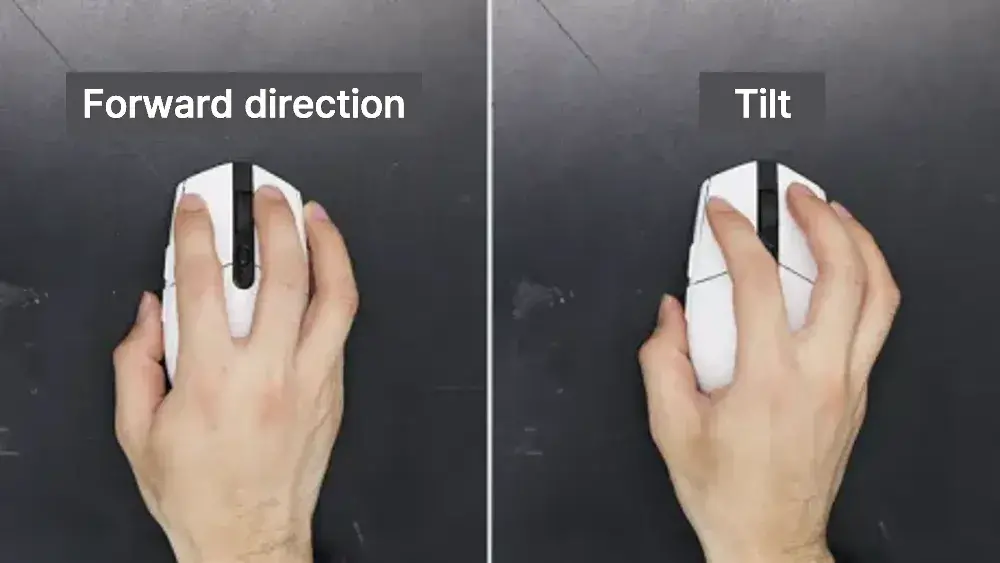
For claw or fingertip grip, regular or smaller size works better. Also check wrist angle – if your wrist naturally stays straight, choose a flat mouse. If it tends to tilt, choose a tilted mouse design.
Choose Shape and Size Based on
Grip Style and Hand Size Combination

After determining grip style and hand size, use the table above to select an appropriate mouse. For example, palm grip users with average hand size should choose a regular-sized mouse.
2. Weight
Standard Mice ~0.22 lbs
Sub-0.18 lbs Light but Expensive
Standard mice typically weigh 0.20-0.22 lbs. If you don’t have strong weight preferences, 0.20-0.22 lbs is a safe choice.
Due to the small size of mice, even 0.02 lbs differences are noticeable. Generally, 0.20-0.24 lbs is considered standard weight, while under 0.18 lbs is classified as lightweight.
Light Mice Better for Small Hands, Claw/Fingertip Grips
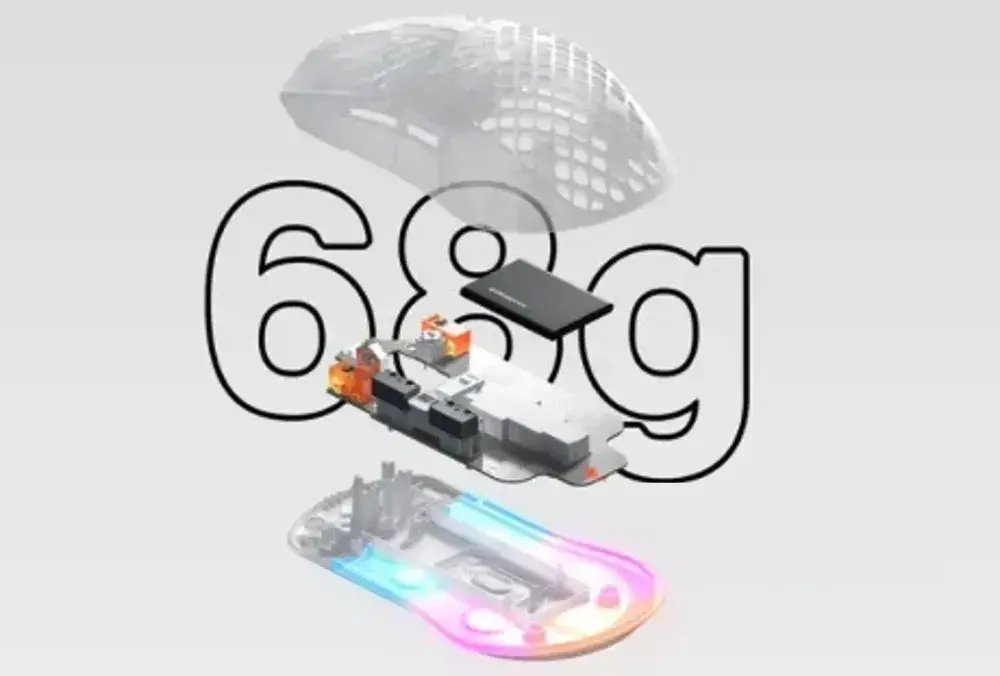
Lightweight mice under 0.18 lbs reduce wrist strain and typically suit smaller hands better. However, users with larger hands may find them harder to grip precisely, and they can feel overly sensitive to small movements. These smaller, lighter mice usually work better for claw or fingertip grip users.
Heavier Mice Better for High DPI Users and Palm Grip
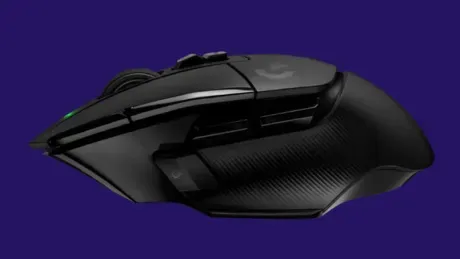
Users who prefer high DPI settings for precise movements and palm grip users often benefit from heavier mice.
Some Models Include Adjustable Weights
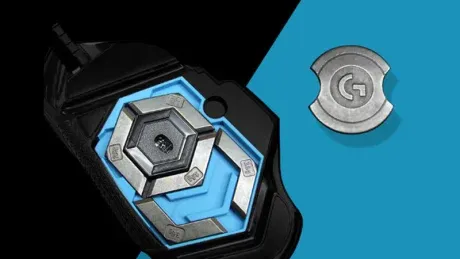
Some mice come with weight customization options. This feature is common in premium gaming mice, where users are particularly sensitive to weight balance.
Weight Preference Highly Personal
Regular Mice Stay Heavier
Gaming Mice Trending Lighter
While there are general guidelines for mouse weight in different situations, grip and weight preferences are highly personal. Weight-sensitive users should try mice in person at stores or borrow from friends to test.
Chapter 4.
Additional Features
Features That Enhance Mouse Usability
1. Button-Related Features
Auxiliary Buttons for Quick Actions Infinite
Horizontal Scroll for Productivity
Auxiliary Buttons Speed Up Work
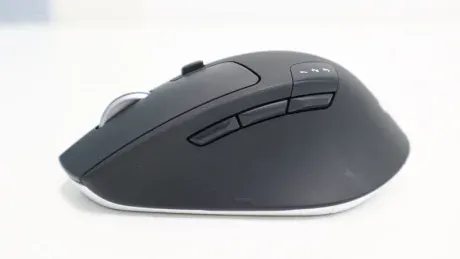
Side buttons typically located near the thumb position usually default to Forward/Back browser navigation. Some models allow customization through dedicated software or macro assignment for different functions.
Fast Navigation with Infinite/Tilt/Horizontal Scroll
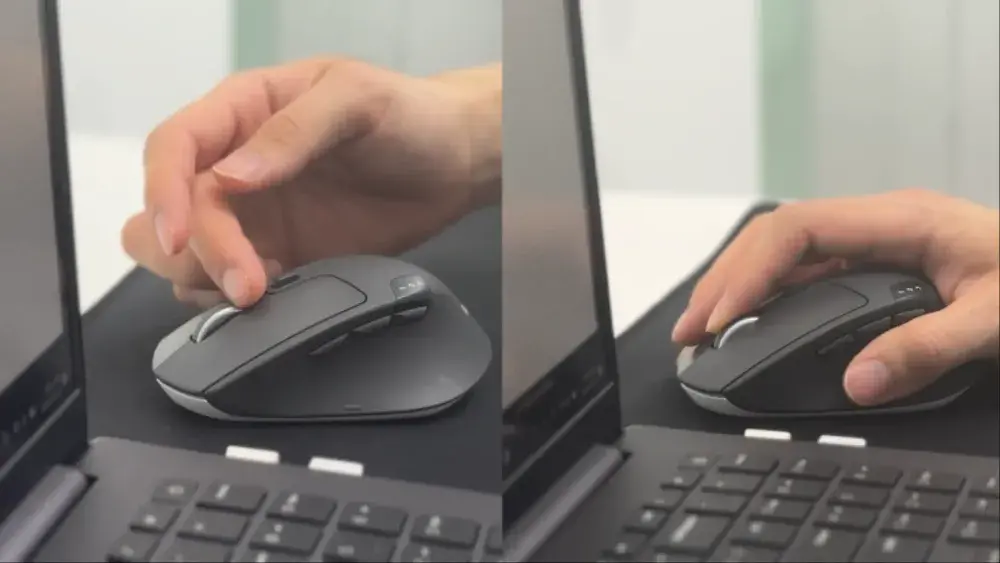
Left = Infinity Wheel / Right = Tilt Wheel
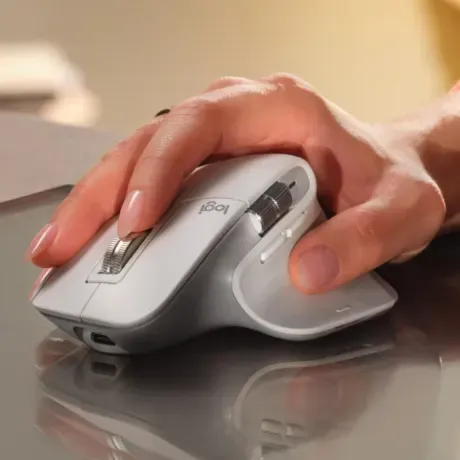
Source = Logitech MX Master 3S
For users who frequently browse the web or work with Excel, mice with infinite scroll or horizontal scroll features are extremely convenient.
Infinite scroll allows quick navigation to the top or bottom of pages with a strong wheel spin. Tilt wheel functionality lets you click the scroll wheel left/right for horizontal scrolling.
The horizontal scroll wheel, typically placed near the thumb, is particularly useful for Excel work and video editing, providing dedicated horizontal scrolling capability.
2. Dedicated Software
Customize Button Macros, Wheel Sensitivity,
DPI, RGB Lighting, and More
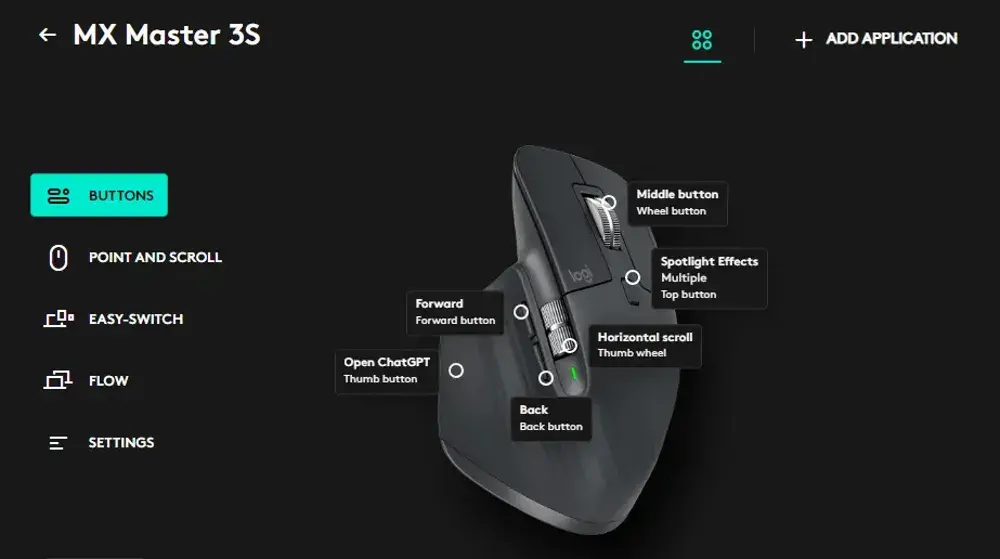
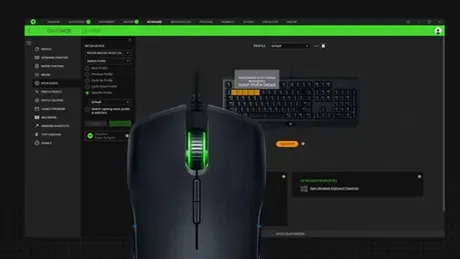
Note: There appears to be some text about towel price comparison that seems out of place in the original – I’ll skip that and continue with the relevant content.
3. Wireless Charging Pads
Mousepad That Charges Compatible Wireless
Mice While In Use
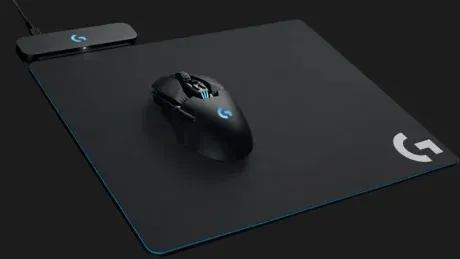
If you want to use a wireless mouse but worry about forgetting to charge it, consider a wireless charging mousepad. These eliminate charging concerns completely – just make sure your mouse is compatible with the charging pad before purchase.


